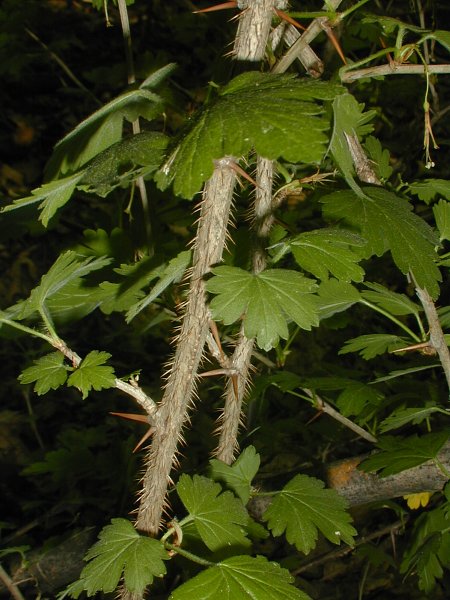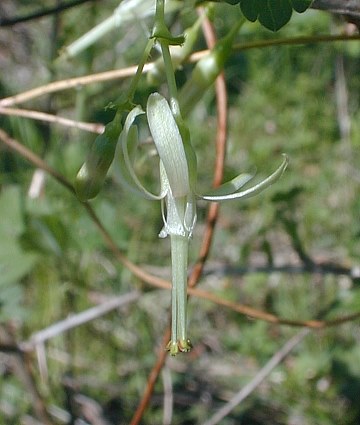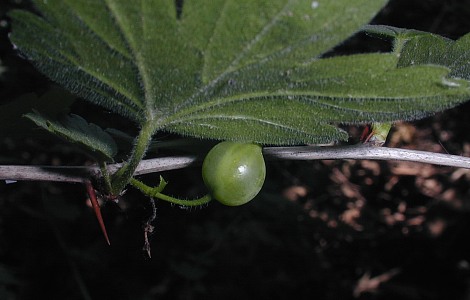Description: This woody shrub is about 2-4' tall, branching occasionally. Young branches are green, but older branches become gray or brown and woody. The branches have two different kinds of thorns: large straight thorns (about ½" or longer) that are reddish brown and small straight thorns (¼" or less) that are brown. The large thorns occur in bunches of 1-3 where the petioles of the leaves occur (or used to occur), while the small thorns are abundant on the larger branches. However, smaller branches may lack small thorns altogether. The deciduous leaves occur alternately along the stems in bunches of 1-3. Each leaf is up to 2" long and across and palmately lobed; there are 3-5 major lobes and several smaller lobes (or large teeth that are crenate). Each lobe is cleft and tapers to a blunt point. The base of each leaf is slightly cordate, truncate, or obtuse. The upper surface of each leaf is hairless to slightly pubescent, while the lower surface is nearly hairless to pubescent. The petiole of each leaf is somewhat hairy and about ¾–1½" long.

Near the base of some leaf petioles, a raceme or corymb of 1-3 flowers is produced. The stalk of this inflorescence spreads horizontally, while the flowers droop downward on slender pedicels. Each flower has a narrow tubular calyx with 4-5 linear-oblong lobes, a similar number of strongly exerted stamens, and a smooth ovary at its base; this flower is up to ½" long (including the stamens). The tubular calyx and its lobes are white (sometimes tinted green or purple); the stamens are at least twice as long as the tubular calyx. The blooming period occurs during late spring and lasts about 2 weeks. Each fertilized flower is replaced by a globoid berry about 1/3" (8 mm.) across or a little larger; this berry is initially green and glabrous, but it later becomes dull red or dull purple. There are no prickles on the surface. The berries are juicy and contain many minute seeds. The root system is woody and branching.

Cultivation:
The preference is partial sun, mesic to slightly dry conditions, and
loamy or rocky soil with organic material to retain moisture. In
excessive shade, flowers and fruit may not be produced. Gooseberries
and currants (both Ribes spp.) can be hosts to
White Pine blister rust. This is not usually a problem in Illinois, as
White Pine and its relatives occur in boreal areas to the north of the
state.
Range & Habitat:
The native Missouri Gooseberry is occasional to locally common in
central,
northern, and SW Illinois, but it is absent in the SE and south-central
areas of the state (see Distribution
Map). Habitats include mesic to dry open woodlands, savannas,
woodland borders, thickets, powerline clearances and small meadows in
wooded areas, abandoned fields, and partially shaded fence rows.
Occasional disturbance is beneficial if it removes some of the overhead
tree canopy.

Faunal
Associations:
The nectar and pollen of the flowers attract primarily bees, including
honeybees, bumblebees, cuckoo bees (Nomada spp.), mason bees (Osmia
spp.), Halictid bees (including green metallic bees), and Andrenine
bees. Less common floral visitors include bee flies (Bombylius spp.),
butterflies, clearwing moths (Hemaris spp.), and Syrphid flies. Syrphid
flies feed on the pollen, but they are not effective at
cross-pollination (Robertson, 1929; Graenicher, 1907; Wilhelm &
Rericha, 2017). Other insects feed destructively on the foliage, fruit,
and other parts of Missouri Gooseberry (Ribes missouriense) and other Ribes spp.
These species include leaf beetles, plant bugs, aphids, leafhoppers,
armored scale insects, larvae of gall flies, larvae of sawflies, larvae
of Geometer moths, and larvae of eye-cap moths (Opostegidae). In
addition, the larvae of two butterflies, Green Comma (Polygonia faunus)
and Gray Comma (Polygonia progne), feed on the foliage. See the Insect Table
for more information. The fruits of gooseberries are eaten by several
species of songbirds and upland gamebirds, and as thorny shrubs they
provide good protective cover and nesting habitat for some of them (see
Bird Table).
Mammals that feed on the fruits occasionally include the American Black
Bear, Raccoon, White-footed Mouse, and Deer Mouse (Noyce &Coy,
1990; Romain et al., 2013; Martin et al., 1951/1961; Hamilton, 1941).
Notwithstanding the thorns, White-tailed Deer sometimes browse on the
leaves and young branches (personal observation). Fruit-eating birds
and mammals help to spread the seeds of these small shrubs to new
locations.
Photographic Location:
The edge of a deciduous
woodland at Busey Woods in Urbana, Illinois. The fruit in the lower
photograph is still immature.

Comments: This is the most common gooseberry in Illinois (excluding cultivated forms). Like many other gooseberries, it is a rather spiny shrub with palmately cleft leaves and odd drooping flowers. Missouri Gooseberry differs from Ribes cynosbati (Prickly Gooseberry), a less common species in Illinois, by the smooth surface of its berries; the latter has berries with a conspicuously prickly surface. The leaf bases of Prickly Gooseberry are usually more cordate than those of Missouri Gooseberry, and the stamens of its flowers are not exerted beyond the tubular calyx. Another species, Ribes hirtellum (Northern Gooseberry), is restricted to northern Illinois. This species has yellowish green flowers with tubular calyxes that are more broad, and its exerted stamens are up to twice the length of the corollas. Missouri Gooseberry has flowers that are more or less white; they have narrow tubular calyxes with exerted stamens that are at least twice the length of the calyx tubes (excluding their lobes). The branches of Missouri Gooseberry are usually more thorny than those of Northern Gooseberry; the larger thorns of the former are ½" or more in length, while the thorns of the latter are less than ½" in length.